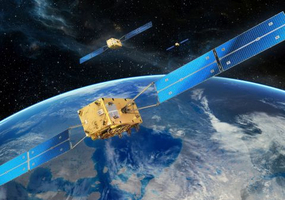Navigation and Scientific Satellites

The Grand Tour: Venus, Jupiter & Saturn - Probe: CASSINI-HUYGENS (instrument: CDA)
Launched on 15 October 1997, the probe has been travelling in space for 18 years. After a number of "fly-bys" around Venus, Earth and Jupiter, Cassini swung into orbit around Saturn on 1 July 2004. It carried on board the Cosmic Dust Analyser (CDA) for the simultaneous measurement of the electrical charge, speed, flight direction, mass and chemical composition of the individual dust particles – especially in the area around Jupiter and Saturn. The severely restricted self-rotation of the probe meant that the CDA needed to be targeted with absolute precision: The sensitive structure is connected with the probe by a high-resolution turntable made by the Pahl engineering company in Munich and driven by a Phytron precision stepper motor (diam. 32mm) with gear (1000:1). To reduce the stray magnetic field, the motor is fitted with a special magnet configuration and mu-metal shielding. An electronic controller optimised for this application drives the motor with currents between 150 and 300 mA with a consumption of 2-5 W, to save energy.
The system needed to be able to withstand start-up accelerations of 15 g and acoustic loads of up to 150 dB. The probe will be investigating the rings of Saturn in the next few months and then end its scientific mission, probably on 15 September 2017, after 20 years in service when the probe enters Saturn's atmosphere.
Vesta & Ceres – Probe: DAWN (instrument: framing cameras)
The DAWN space probe has been travelling through our solar system since 27 September 2017. After stopping over in the orbit of the asteroid Vesta (2011-2012), DAWN has now approached Ceres. The German camera system on board is used both for navigation and for mapping the surface of the asteroid. The scanned bandwidth allows the composition and nature of the asteroid to be determined.
Ambitious scientific missions such as DAWN are enabling science to conquer space, with its extreme ambient conditions. The fact that DAWN is still sending high-resolution images back to earth after 8 years in space is thanks to the developers of the framing cameras. The staff at the Max Planck Institute for Solar System Research (MPS) led the development and worked closely with the German Aerospace Centre (DLR) and the Institute of Data Engineering and Communication Networks (IDA) at Braunschweig Technical University. They relied here on high-quality components suitable for use in space. In addition to the electronics, this requirement applies in particular for the mechanical elements and electrical drives, which need to operate reliably, even after extreme vibrations when the rocket is launched and with major fluctuations in temperature.
Phytron's VSS Space precision stepper motors (diam. 25mm, 200-steps) adjust the filter wheels of the two on-board cameras and drive the spindle-driven mechanism of the shutter which protects the sensitive camera lens from dirt and damage.
If the motor or the control electronics suffer damage during the mission, the shutter can be permanently opened by melting through the retaining cable. However, the robust operating principle of stepper motors and their control electronics make any failure highly unlikely.


